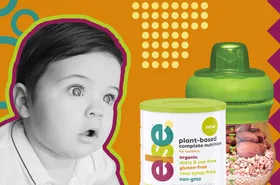Essential Guide to Vitamin D and Calcium for Kids
Ensure your child gets the right amount of calcium and vitamin D. Explore daily recommendations, benefits, and top food sources for healthy development
Published August 8, 2024

Research shows that approximately 42% of Americans (including children) do not meet their daily calcium needs. If you’re wondering whether your child might need supplemental calcium or are confused about how much they actually need, you’re not alone. Understanding calcium intake can be overwhelming, but it’s crucial for your child's growth and development.
In this guide, we’ll break down everything you need to know about calcium for kids—from daily recommendations to the best calcium-rich foods you can incorporate into their meals. Read on to ensure your child is getting the calcium they need for a healthy, strong future.
» Discover plant-based nutrition designed to meet your kid's vitamin and mineral needs
Vitamin D and Calcium for Kids Explained
Before we explain the importance of calcium for children, let’s touch on the basics of this nutrient. Calcium is a mineral found in various foods, including dairy products, which are the most popular source. It is stored in the bones and teeth. Often, discussions of calcium also include mentions of vitamin D. This is because we need vitamin D to properly absorb and utilize calcium.
Vitamin D is a fat-soluble vitamin that supports calcium absorption and increases magnesium and phosphate absorption. It is produced by the skin when exposed to direct sunlight. Vitamin D can also be obtained in supplement form and from some foods.
» Find out more about essential nutrients for kids
What Is the Recommended Daily Amount of Calcium and Vitamin D?
Most parents have questions about how much vitamin D and calcium their child should be getting. The answer depends, though, on their age.
| Age Group | Daily Calcium Requirement | Daily Vitamin D Requirement |
|---|---|---|
| Birth to 6 months | 200 mg | 400 IU |
| 6 to 12 months | 260 mg | 400 IU |
| 1 to 3 years | 700 mg | 600 IU |
| 4 to 8 years | 1,000 mg | 600 IU |
| 9 to 18 years | 1,300 mg | 600 IU |
» Discover how to bridge nutritional gaps for your family and ensure a healthier future
Why Is it Important to Get Enough Calcium and Vitamin D?
Now that you can easily answer the question, “How much calcium do kids need?” let’s explore the benefits of calcium and vitamin D.
Benefits of calcium for kids
Calcium is stored in the bones and teeth to help keep them healthy and strong. If children don’t get enough calcium in their youth, they may be more prone to dental problems, fractures, and bone conditions like osteoporosis when they get older.
Calcium also supports healthy nervous system function and muscle function. It helps to regulate blood pressure, too.
Benefits of vitamin D for kids
Vitamin D helps to improve calcium absorption, so it’s also necessary for strong and healthy bones and teeth.
Vitamin D also plays a key role in several other bodily processes. For example, it strengthens the immune system and reduces kids’ risks of developing various illnesses and infections.
» Explore plant-powered, vitamin-enriched nutrition for your little ones
Should You Give Your Child a Calcium Supplement?
Most kids don’t require a high-dose calcium supplement, especially if they eat plenty of calcium-rich foods.
That being said, some kids may be more prone to calcium deficiencies than others. For these children, it can be helpful to incorporate some supplemental calcium into their routine to fill in the gaps and ensure they’re not missing out on any benefits. The following are some children who may not be getting enough calcium in their diets:
- Kids who are allergic or sensitive to dairy products
- Kids who don’t eat dairy products for ethical or dietary reasons (i.e., vegans)
- Kids who are picky eaters and don’t gravitate toward calcium-rich foods
» Uncover more about nutrient deficiencies in children
Can Kids Have Too Much Calcium?
If kids consume too much calcium, they may develop hypercalcemia (or excessive calcium in the blood). This condition is unlikely, though, unless the child is far exceeding their daily calcium recommendation by taking too many supplements (i.e., taking in over 2,000 milligrams of calcium per day). You cannot get too much calcium from food alone.
Hypercalcemia can also occur if the child has a problem with their parathyroid gland, which produces a hormone that regulates blood calcium levels. They may also develop this issue if they’re not getting enough vitamin D, which helps them absorb calcium into the bones and teeth.
Some signs of hypercalcemia include abdominal pain, nausea, constipation, and muscle twitches.
» Find more expert tips on nutrition for babies, toddlers, and kids
The Best Calcium-Rich Foods
Dairy products are typically the first thing that people think about when they think about high-calcium foods. There are plenty of other good options, though, including plant-based foods and beverages.
Whether you’re looking for high-calcium foods for toddlers or calcium-rich foods for kids eating a plant-based diet, this list has some of the best options:
Soy milk
For kids who can’t or refuse to drink dairy milk, soy milk is a great alternative.
Not only is soy milk a good source of plant-based protein, but many varieties are also fortified with calcium. This makes it an excellent option for drinking plain, adding to cereal, or mixing into a smoothie.
Fortified orange juice
Many orange juice brands are also fortified with additional calcium. Some contain as much as 500 milligrams per cup!
Whether your kids don’t want to drink milk at all or if they just need some variety in their diet, fortified orange juice is a good drink to keep on hand.
Tofu
Tofu is a highly versatile plant-based food that can also be a good source of calcium.
The key is to check how it was prepared. Tofu made with calcium sulfate will naturally be higher in calcium than tofu made with magnesium chloride.
Almonds
Almonds are loaded with calcium and are a fun, simple snack for kids. One serving of almonds (about ⅓ of a cup) contains 110 milligrams of calcium.
Raw and roasted almonds are both good sources of calcium, as is almond butter, which can be spread on bread for sandwiches, tossed in a smoothie, or mixed into yogurt.
Sweet potatoes
When most people think of sweet potatoes and their nutrient content, they first think of vitamin A. What they don’t realize, though, is that these orange root vegetables contain calcium, too.
A cup of cooked sweet potato contains about 76 milligrams of calcium. While it won’t fully satisfy most children’s needs, it will make a good dent in their daily intake.
Beans
Many different types of beans are good sources of calcium as well.
For example, boiled white beans contain about 130 milligrams of calcium per cup, and canned white beans contain around 190 milligrams. Canned chickpeas contain calcium, too (approximately 80 milligrams per cup).
Broccoli
Two and a quarter cups of broccoli contain the same amount of calcium as a cup of milk (about 300 milligrams).
For most parents, the idea of their child eating that much broccoli, plain, is downright laughable. To make it more enticing, try topping it with a little cheese (regular or dairy-free) or giving them a reasonable serving of Ranch dressing (about 2 tablespoons) for dipping.
Green peas
One cup of green peas contains about 45 milligrams of calcium. That might not seem like a lot, but green peas also contain vitamin K, which can support kids’ bones and teeth.
Vitamin K may help to increase bone mineral density and strength. It regulates calcium deposition and prevents calcium from building up in the blood vessels or kidneys.
Calcium-fortified cereal
Finally, many brands of cereal are fortified with calcium. Even if your child doesn’t drink dairy milk with their breakfast, they could still be getting plenty of calcium from the cereal itself.
Check nutrition labels when shopping for cereal to find an option that contains a good amount of calcium per serving.
Should You Give Your Child a Vitamin D Supplement?
What about vitamin D? Should you give your child a vitamin D supplement in addition to their supplemental calcium?
If your child spends plenty of time outdoors in the sun, you might not need to worry about their vitamin D levels. However, vitamin D supplementation can be beneficial during the fall and winter months when sun exposure is lower. Children who fall into these categories may need supplemental vitamin D:
- Kids who do not spend a lot of time in the sun (those who live in cloudy climates, those who burn easily, etc.)
- Kids who have darker skin (higher melanin levels slow down vitamin D synthesis)
- Kids who do not eat a lot of vitamin D-rich foods, either for ethical reasons or because of pickiness
For parents who are worried about their kids’ vitamin D or calcium intake, it’s best to check with a doctor before giving them any kind of supplement. The doctor can assess their diet and perform tests to evaluate whether or not supplementation is necessary.
» Here's how to create a balanced diet for your kids with enough vitamin D
Can Kids Have Too Much Vitamin D?
If children consume too much vitamin D, they may be more prone to kidney stones, which can develop when calcium enters the blood vessels and kidneys. This only applies to supplemental vitamin D, not the vitamin D your body makes naturally from the sun.
- For infants, vitamin D intake should not exceed 1,000-1,500 IUs per day.
- For kids aged 1-8 years, vitamin D levels of 2,500-3,000 or higher are considered problematic.
- For kids age 9 and older, exceeding 4,000 IUs of vitamin D per day could increase their risk of complications.
What Foods Are High in Vitamin D?
Vitamin D is found mainly in animal products like salmon, egg yolks, and sardines. However, a few plant-based foods and drinks contain noteworthy amounts of this important vitamin, and many of them are more appealing to kids than fish and egg yolks. Here are some options to keep in mind.
Mushrooms
Mushrooms are the best source of vitamin D among plant foods. They are interesting because, like humans, mushrooms can synthesize vitamin D when exposed to UV light.
Wild mushrooms, in particular, contain a lot of vitamin D (up to 2,300 IU in a 3.5-ounce serving in some cases). Some commercially grown mushrooms (what you’ll find in most grocery stores) also contain 130-450 IUs of vitamin D per 3.5-ounce serving.
Vitamin D-fortified milk
In the same way that many plant-based milk products, including soy milk, are fortified with calcium, several are fortified with vitamin D, too. Fortified milk is a good way to fill in gaps in a child’s diet and ensure they’re getting enough of this essential vitamin.
Vitamin D-fortified cereal
Many cereal brands are fortified with vitamin D, too. In combination with fortified milk, your child’s favorite breakfast could easily become the perfect vehicle for them to meet their daily vitamin D needs (or at least supplement what they’re getting from other sources).
» Discover more about healthy, vitamin-rich foods for toddlers
Increase Your Child’s Calcium and Vitamin D Intake Today
Now that you know more about the importance of vitamin D and calcium for kids, what do you think? Is it time to start increasing their intake of these important nutrients? Check out our Nutritional Protein Shakes for Kids!
If you need help adding more calcium and vitamin D to your child’s diet but need to be mindful of allergies and sensitivities (or if you just want them to consume a plant-based, animal-product-free diet), Else Nutrition offers a variety of supplements that contain everything they need to thrive, including calcium and vitamin D, without anything they don’t.
The content and advice provided in this article are for informational purposes only and are not a substitute for medical diagnosis, treatment, or advice for specific medical conditions. Always consult a pediatrician to understand your child's individual needs.










